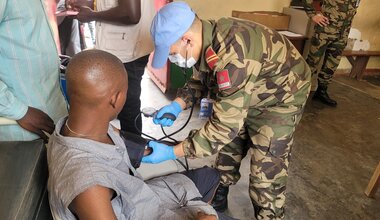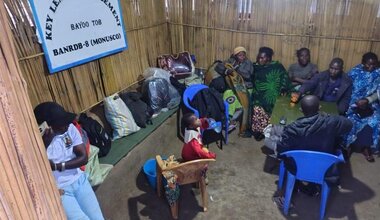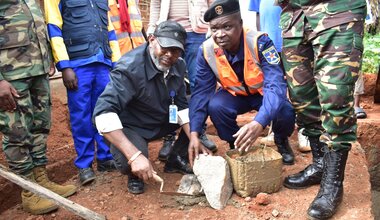HIV prevention in the hands of women
Goma, 25 march, 2018 – The entire month of March, called the month of the Woman, has been reserved for activities related to International Women’s Day celebrations. The commemorations marking this day are activities set aside to celebrate women’s achievements throughout the world. Its purpose is also to promote women’s equality, encourage support for repressed women and promote appreciation toward women everywhere around the world. Many organizations, including the United Nations, use this day to also celebrate extraordinary achievements of ordinary women.
On Saturday, 24 March 2018, MONUSCO Field Office in Goma joined hands with local women’s groups to commemorate this very important day within MONUSCO’s premises in Goma. At the occasion, the HIV/AIDS Section saw it as a good opportunity to raise awareness about how women can protect themselves from contracting HIV which, without treatment often leads to AIDS.
More than three decades into the HIV epidemic, gender inequality and human rights violations continue to put women and girls at greater vulnerability to HIV. Reports indicate that the impact of HIV and AIDS on women, in part, is blamed on gender roles in most communities. When I talked to some of the women who attended this event, most of them confirmed that addressing gender issues remains critical to achieving an AIDS-free generation, not only for women, but also for men as well.
In some households, the responsibility and burden of looking after orphans of AIDS and vulnerable children is often relegated to women. In Sub-Saharan Africa, reports say, most care-givers for people living with HIV are women. According to one of the women, prevention of mother to child transmission of HIV is one programme that women need to actively participate in to interrupt the spread of HIV.
“Women living with HIV, who are also celebrated on Women’s Day, are critical in preventing the spread of HIV”, she says indicating that on Women’s Day, it is a great opportunity to educate women about the importance of HIV prevention, treatment, care and support. “Women also need to be educated on ways that would help reduce the burden of HIV and AIDS”, she stressed.
In spite of several milestones achieved in HIV prevention, treatment, care and support, it is important to recognize that all women across the world are still directly and indirectly affected by AIDS.
Another woman says that violence against women is also a key challenge to HIV prevention. “Women suffer in this issue of HIV than men. A good percentage of women around the world experience emotional, physical, and sexual violence”, she recalls. “This limits their ability to negotiate for safer sex with their male partners”. As she explains, “education and empowerment of women are critical factors in HIV prevention”. She says, “If more women can have the necessary knowledge and information on HIV prevention, they can be able to educate their respective families as well as their communities on ways to prevent HIV”.
 UN
UN United Nations Peacekeeping
United Nations Peacekeeping






